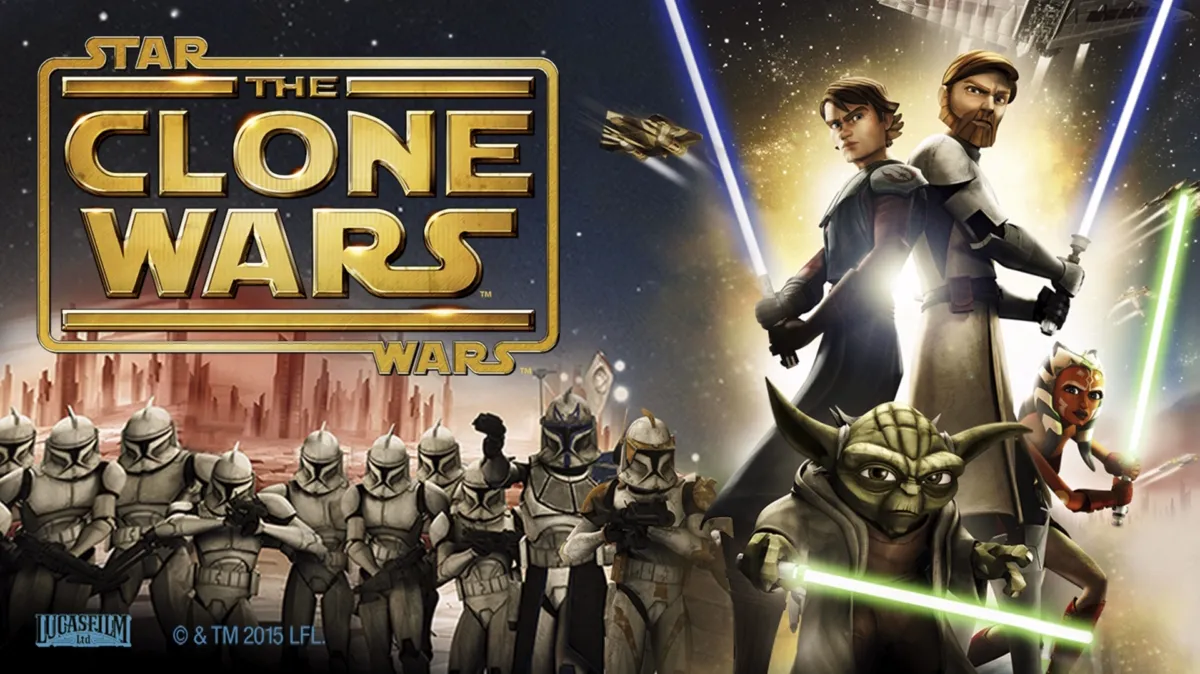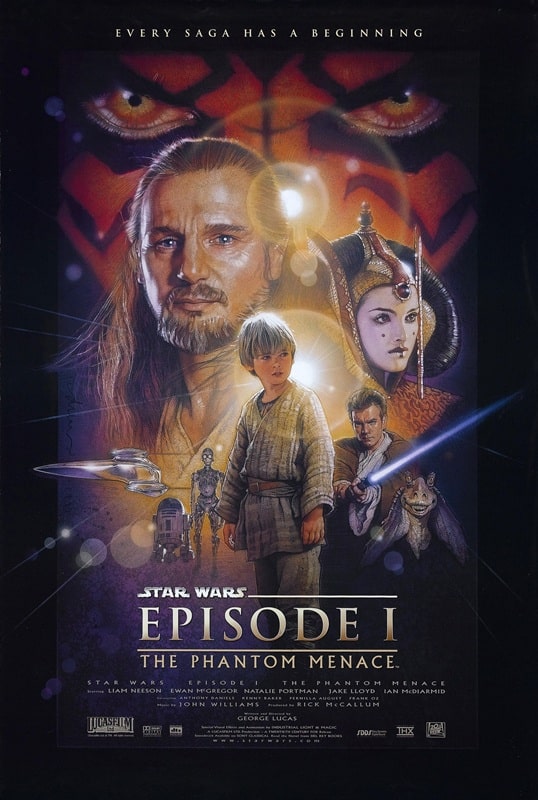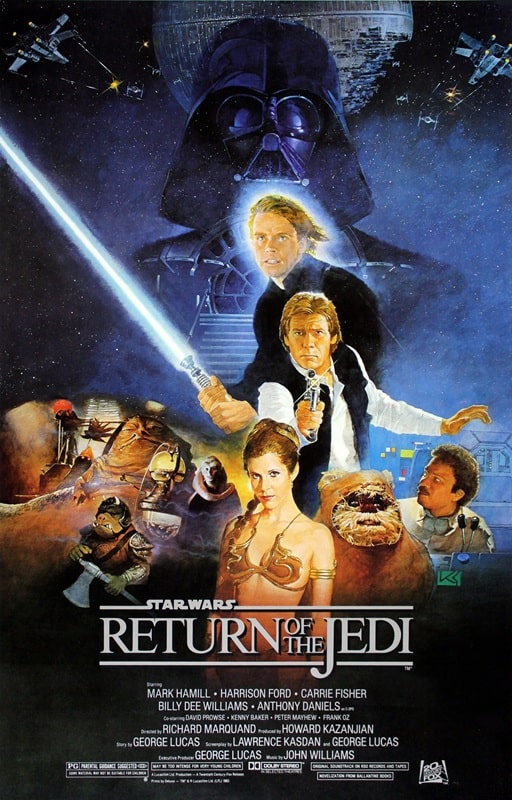The Star Warses — Part 1
It would seem my film lists and reviews haven’t been controversial enough, because our esteemed leader recently yelled down from the lofty belfry of Black Gate Tower and asked me to expand a little on my current Letterboxd rankings of the documentary series known collectively as The Star Wars Saga.
Essentially the rankings boil down to how the films make me feel, based purely on that initial hit I received in 1977 aged 10, when my world turned upside down.
These films are important to many of us for various reasons. They’ve dominated my life for almost 50 years, and influenced my marital status (for the better), my careers (mixed results), even my kids’ names (just ask my eldest, Salacious).
[Click the images to become one with the force.]
The Force, and everything connected to it, is the least interesting aspect to the saga for me — I just love stories about everyday folk living in that galaxy — and you’ll soon see how that influences my film placement. You don’t need an essay for each one, so I’ll just briefly mention what I like or dislike about each film — can’t hate any of them though!
Note: there are no Ewok films or Holiday Specials in this list. I have my reasons.
In reverse order (to squeeze a bit of excitement out of this list).

#12 – The Clone Wars (2008)
An extended advert for the upcoming Clone Wars series, this story that takes place between episodes 2 and 3 fleshes out Obi Wan and Anakin’s relationship, introduces a major new character, and lays the groundwork for a slew of tales that would eventually add great dollops of context to galactic war and all its players.
The animation style would eventually grow on me, but I initially disliked the beanpole character models and architectural features. My (still) favorite Star Wars animated series is Genndy Tartakovsky’s original Clone Wars run — a series of highly stylized vignettes depicting campfire tales of varying exaggeration — and this film, a trio of episodes stitched together, really doesn’t have a cohesive enough story for the big screen.
Also, I was absolutely NOT a fan of young Ahsoka and she, combined with Rotta the Hutt, means this is the only Star Wars flick I’ve not seen more than once.
5/10

#11 – The Rise of Skywalker (2019)
I don’t have a problem with the sequel trilogy; each film contains some extraordinary moments in them that I dig, and the effects and sound design are spot on. Also, it must be said that this is the trilogy for my children (the prequels were the films for the 10-yr-olds I was teaching at the time, more on that later), and so I allowed myself to enjoy them through their eyes.
Ha, who am I kidding? I would have watched them multiple times with or without kids 🙂
My issue with this entry is the ‘slapped togetherness’ of it all. I am well aware of the production issues (and we dodged a bullet when you look at Trevorrow’s script), but the disrespect shown to several characters (Finn and Rose not being the least) and the perceived fan-pandering after the orchestrated backlash to The Last Jedi, meant I’ve only watched this one twice, and it didn’t get any better.
6/10

#10 – The Phantom Menace (1999)
Amusingly, for a film so low down on this list, I’ve watched this one more than a dozen times, several times on the big screen.
Addressing the gungan in the room, I’ve flip-flopped over my feelings for Jar Jar ever since that first watch, first disliking, then tolerating, then enjoying, then back to disliking the problematic goof. Judging by the number of times he pops up in my Star Wars collection (40 tote boxes and counting), I guess he’s just turned into ‘another character,’ one that I subconsciously tune out.
Otherwise, I find the film rather tedious now. Sure, the podrace is a thrill, and the sound of Sebulba’s engines does unspeakable things to me, but watching it now is a bit of a chore. The last time I watched it was in 2012 when it had a theatrical 3D rerun, and Williams’ music and the sound effects rekindled a little bit of childlike excitement for me, but I haven’t watched it again since, or perhaps I have and just forgotten. Oh dear.
I should add that when this came out, I was teaching 10-yr-olds, and to experience the beginning of the prequel trilogy through their eyes was tremendous fun — plus it made our lessons infinitely more interesting. They all LOVED jar Jar.
6/10

#9 – Return of the Jedi (1983)
Oof. This is where things get rough, and I don’t blame you for creating a wax effigy of me and tossing it in the toaster, but RotJ just doesn’t float my desert skiff, and I’ll tell you why. I was 16 when it released, and far from being distracted by other stuff like sports and girls, I was still a full-fledged nerd. However, the muppety denizens of Jabba’s palace and the bloodthirsty stuffies of the forest moon pulled me out of the film, defeating even the lure of a gold bikini and speeder bikes.
I’ve since softened to the overall feel of the film, and embraced Max Rebo and his cohorts (although I still can’t stand Ewoks), but it’s definitely the weakest of the original trilogy despite containing the second best Williams piece of the entire saga — The Battle of Endor. Are you getting mad yet?
7/10

#8 – Attack of the Clones (2002)
Yeah, you heard me, Attack of the Clones. I am constantly mystified by the hatred for this film that can more often than not be found languishing at the bottom of other folks’ lists. I get that petulant Ani, love in the meadow, the droid factory cut scene, and other minor issues rub many a viewer up the wrong way, but there’s so much more fabulousness stuffed into it that I’m able to overlook its faults.
Foremost for me is the sound design; from Zam Wessell’s screeching air speeder, to the gritty chaos of war on Geonosis, and the greatest sound of all in the entire franchise, seismic charges. Seriously, when I saw the truncated version of the film in IMAX (the aforementioned meadow romance was cut out), Jango Fett’s glorious space bombs fair blew my pants off. Such happy memories.
Aside from these lovely noises, there is much more that makes me giddy in Attack of the Clones. The neon-drenched business of Coruscant — all sports bars and diners, the Harryhausen-esque arena kerfuffle and subsequent saber-fest, the clones doing some attacking, Yoda leaping and twirling around with his glow stick — all enormous fun.
7/10

#7 – The Last Jedi (2017)
The beginning of the end of the ‘civilized’ times, and the film that was hijacked by dude bros and racists to push their agendas. Armchair critique was at its zenith and it was a sad time to be a fan.
However, rather than get mired in further thoughts on the fallout from Rian Johnson’s gently subversive take on the saga, I’ll focus on the elements that buttered my porg, starting with the opening bombing run on Eddie Hitler’s dreadnaught and Poe Dameron’s handbrake turn. As with ESB, we kick off with a big battle, but this time the aggressors fail spectacularly, and this sets us up for the rest of the story.
I dig the Rashoman style storytelling as Luke and Kylo both try to sway Rey, the constant frustrations of the island fishwives, Johnson’s homage to Howard Hughes’ Wings with the fun dolly shot through the casino tables of Canto Bight, the ghastliness of Snoke and Andy Serkis’ amazing performance, and the entire final battle on the salt-encrusted plains of Crait.
Naturally there are some elements I wasn’t overly fond of; Finn’s relegation to general grunt, Holdo’s design (I like the character, not a fan of the look, LOVE the maneuver), or much of the ‘dyad’ stuff, but then I have already stated that the forcy folks are the least interesting for me. Ultimately a lot of fun though.
8/10
Previous Murky Movie surveys from Neil Baker include:
The Star Warses — Part 2
Just When You Thought It Was Safe
Tech Tok
The Weyland-Yutaniverse
Foreign Bodies
Mummy Issues
Ch-Ch-Ch-Ch-Changes
Monster Mayhem
It’s All Rather Hit-or-Mythos
You Can’t Handle the Tooth
Tubi Dive
What Possessed You?
See all of Neil Baker’s Black Gate film reviews here. Neil spends his days watching dodgy movies, most of them terrible, in the hope that you might be inspired to watch them too. He is often asked why he doesn’t watch ‘proper’ films, and he honestly doesn’t have a good answer. He is an author, illustrator, teacher, and sculptor of turtle exhibits.

I have a complicated relationship with Star Wars. I loved the original trilogy when I was 12 – 13, however the older I got and the more well read in SF I got made me think less of it. The prequels weren’t great and I think I might find flaws in the original if I watched it now. That said I did like the first two seasons of the Mandalorian.
I’d say I love about 90% of it all, but I have simple requirements, mostly nostalgic sound effects and dirty aesthetics.
Yes – loved the series and can’t wait for the Mando and Grogu film 🙂
I give George Lucas a lot of credit for producing movies that have captivated so many and are fine entertainment for kids of most ages. I think any ranking of Star Wars movies has so much to do with personal nostalgia that you could justify just about any order. Having seen all of them in the theater (I was 12 when New Hope came out) and the last half dozen with my boys, I agree that the Clone Wars animated movie was one I could have passed on and that the last one (Rise of Skywalker) was so jumbled as to be incoherent (was there a magic dagger in it? ). I have only rewatched the original trilogy but have fond memories of scenes from most of the others.
For sure, we owe Uncle George so so much!
You’re right of course, my ranking is best viewed through nostalgia goggles 🙂